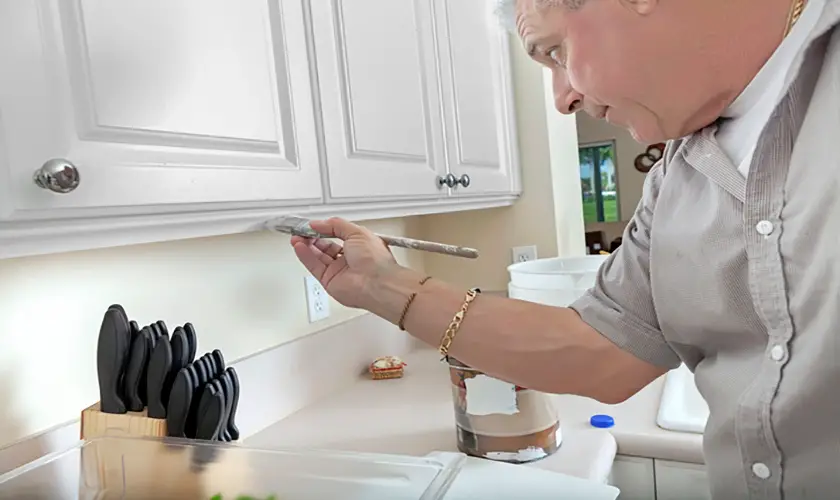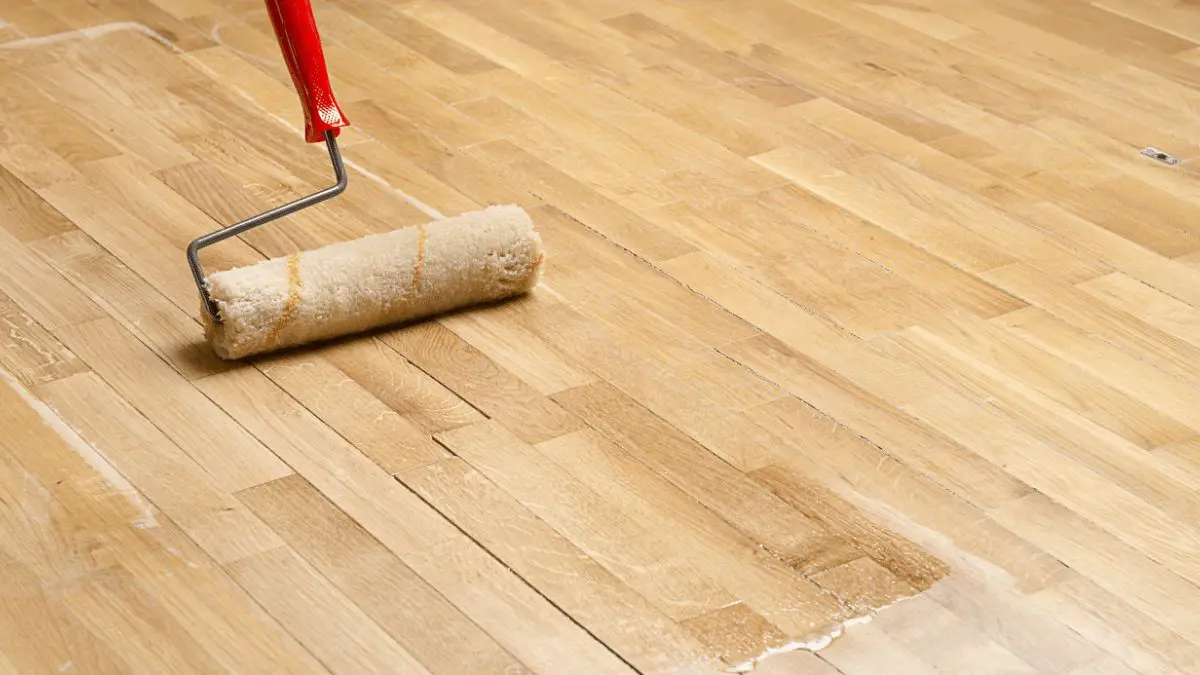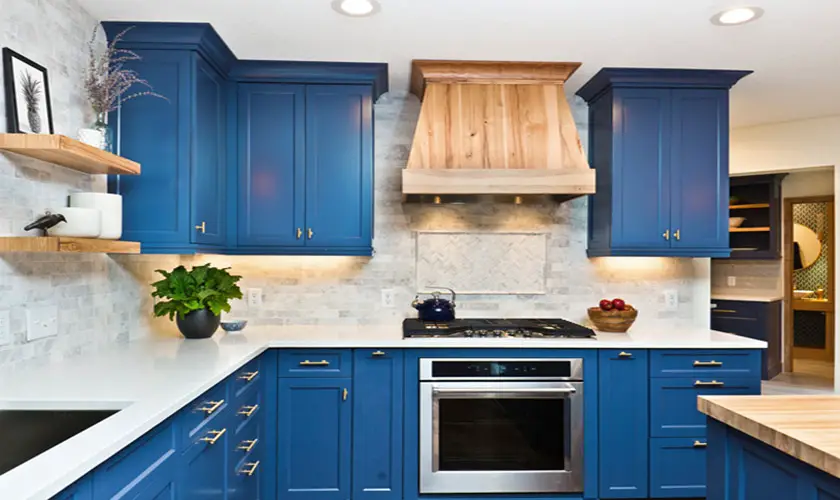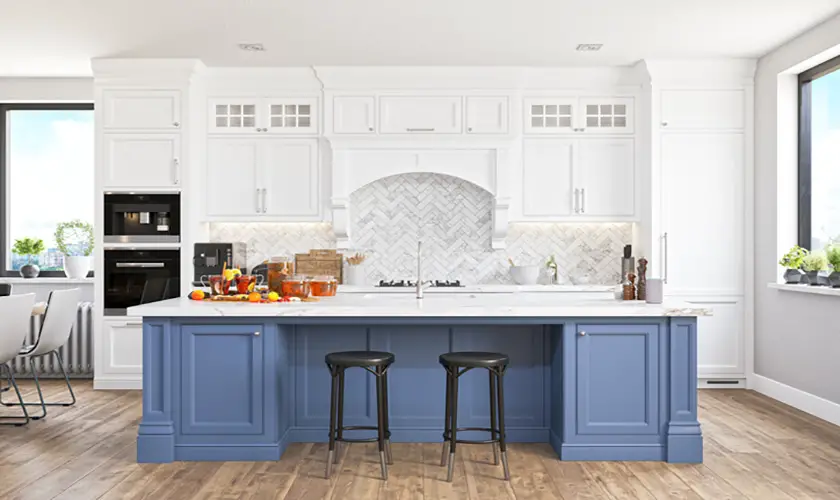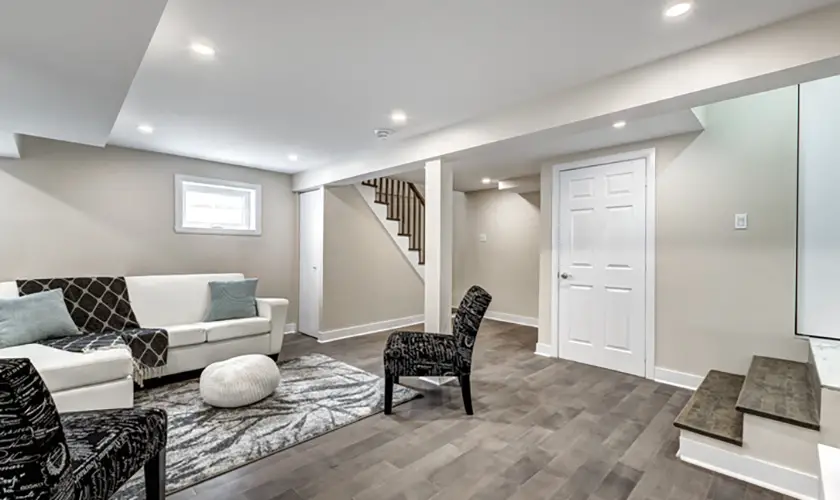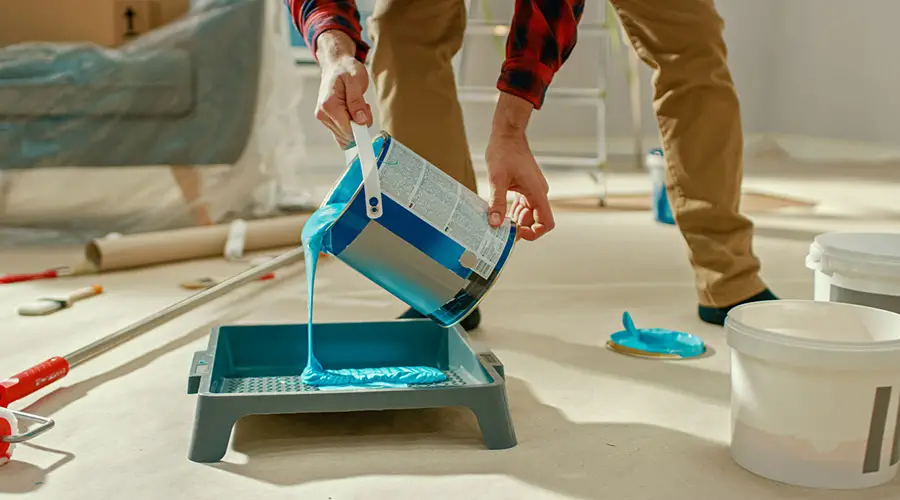
After painting the exterior of your home, you may have a little leftover and are wondering if you can use it on the inside of your house. Generally, using exterior paint for anything other than painting outdoor surfaces is not a good idea, but there are some serious reasons why this is the case.
You should never use exterior paint indoors. Exterior paint relies on sunlight to properly cure and off-gasses large amounts of volatile organic compounds (VOCs). The fumes from exterior paint are much more potent than interior paint, which can cause respiratory problems or worsen existing conditions.
The difference between exterior and interior paint may not be apparent to the casual painter beyond exterior paint being more weather-resistant than paint intended for indoor use. However, there is a significant difference between the two paint types. To get the best results and avoid any harmful side effects, it’s always best to use exterior paint for outdoor surfaces and interior paint for indoor surfaces only.
7 Reasons Why You Should Not Use Exterior Paint Indoors
Why you should only use exterior paint outdoors is not just a marketing thing or some old traditional advice; there are real reasons for it being the case. Regardless, it’s a good rule to always use exterior paint for outdoor surfaces and interior paint for indoor ones.
Most indoor paint formulation attempts to get a nice color, good scratch resistance, and low VOC emissions. On the other hand, exterior paint formulation cares less about lowering VOC emissions and more about durability, temperature resistance, and fade protection.
Below are seven crucial explanations for why you should not use exterior paint on the inside of your home.
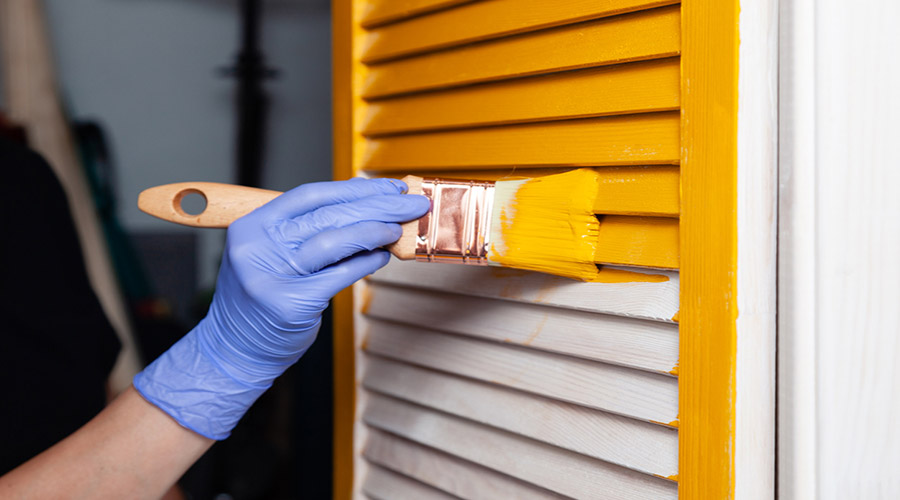
1. Off-Gassing When Drying and Curing
When you first apply paint onto a surface, there is usually a distinct paint smell. This smell is due to the volatile organic compounds (VOCs) and other fumes emitted from the paint. Paints intended for exterior use typically have considerable off-gassing, which isn’t a problem outdoors because there is plenty of airflow outside.
However, when you use exterior paint indoors, there is insufficient ventilation to disperse the toxic fumes adequately. Paint specifically formulated for indoor use has lower, and sometimes zero, VOC emissions. There are three main types of paint:
| Paint Base | Typical VOC Levels | Common Usage |
|---|---|---|
| Water | Low | Interior |
| Latex | Low to Medium | Interior or Exterior |
| Oil | High | Exterior |
VOCs are compounds that release in large quantities, especially in exterior paint. The already harmful compounds react easily with other elements and materials in the air, often creating even more toxic fumes. Exterior paint can take up to 24 hours to dry and multiple weeks to fully cure, so its off-gassing period can be quite long.
2. Long-Term VOC Emissions
When paint containing VOCs is wet right when you apply it, while it’s drying, and while curing, it releases VOCs into the air. These VOCs react with other elements in the air, creating additional toxic fumes that many people associate with the “paint smell.”
However, the VOC emissions do not instantaneously stop after the paint cures. Over the long-run exterior paint continues emitting low levels of fumes that can be harmful. When used as directed outdoors, the small amount of fumes put off by exterior paint is not a problem because of the readily available airflow, but it can be a problem indoors.
Indoors there is typically not enough ventilation to disperse VOCs while the paint is curing and over the long run when levels drop. Such low levels of VOC emissions are pretty harmless, but long-term exposure to small amounts of VOCs can lead to more severe health problems.
3. Needs Sunlight to Cure Properly
Many exterior paints require sunlight exposure when drying and curing. However, there’s a sweet spot because too much sunlight can cause numerous problems when painting, including peeling, inadequate adhesion, and cracking.
Most exterior paints already have a relatively long curing period lasting anywhere from a few days to a month. The drying and curing time frame expectations become unpredictable if you use exterior paint indoors.
Less sunlight exposure and unrestricted airflow can cause paint designed for outdoor use to cure and dry exceptionally slowly. A more extended curing time can lengthen the off-gassing period, releasing more VOCs and fumes into the air.
4. Causing or Worsening Health Problems
Volatile organic compounds (VOCs) are gas emissions that many types of paint, often exterior paint, put out in large quantities when wet and lower quantities once dried. VOCs are not a specific chemical but instead a name for various gasses that easily react with other materials and chemicals in the air.
VOCs can create toxic fumes that can cause or worsen health problems. Nearly all paints emit VOCs, but exterior paint typically releases more than interior paint. Using exterior paint properly outdoors is not a problem because the VOCs and fumes get dispersed and diluted in the air. However, there is less ventilation indoors which can accumulate fumes in your home.
The harmfulness of the VOCs emitted from your particular paint, and your susceptibility to illness determine your reaction’s severity. Some common health effects of exposure to VOCs include headaches, irritation, loss of coordination, and nausea. VOCs have also been linked to an increased risk of kidney damage, liver damage, nervous system damage, and possibly some types of cancer.
5. Not Meant for Drywall
Exterior and interior paints are vastly different functionality-wise. However, they typically share four standard ingredients that serve specific functions:
- Solvent – The solvent ingredient in paint is the primary liquid that evaporates as the paint dries, leaving the rest of the components behind.
- Pigment – Pigment is the ingredient in paint that gives it its color. There are many types of pigments, both natural and synthetic.
- Additives – There are often many additives in paint, which give the paint characteristics such as good application flow, mildew resistance, or sun fading resistance.
- Resin – Resin is the ingredient that helps the paint bond to the surface material. There are three main types of paint resins: epoxy, acrylic, and silicone.
The specific combination of resin and other ingredients determines how well paint applies to the surface material. Most exterior paints bond well with common home exterior materials, such as vinyl, stucco, and wood. On the other hand, paint companies formulate many interior paints precisely for drywall application.
6. Different Texture and Finish
If you compare exterior and interior paint, there is typically a noticeable difference between the texture and finish. While both paint types often have many finish and texture options, it fundamentally comes down to each’s basic formulation regarding their intended purpose.
Exterior paints have different additives and resins than interior paint to help withstand extreme UV radiation, drastic temperature changes, and outdoor weather. Most exterior paints have softer resins than interior paint.
The primary reason for using a softer resin for exterior paint is to allow flexibility. Moisture and temperature changes are typically more extreme outdoors than indoors, so the more flexible resin enables the paint to more easily expand and contract without damage.
7. Prone to Scrapes and Scuffs
While it might sound counterintuitive, outdoor paint is generally more prone to scraping and scuffing than indoor paint. This characteristic of exterior paint is primarily due to the resin ingredient used—which helps bond the paint to the surface.
Outdoor paint formulation focuses on durability against weather, changes in temperature, and resistance against moisture. Additives can achieve many of these goals, but exterior paint often uses a soft resin to allow for expansion and contraction due to temperature. While still durable, the soft resin means the paint can easily sustain damage from everyday indoor use.
Interior paint uses a more rigid resin that helps protect against scratches, scuff marks, and other wear and tear. The temperature indoors is typically more stable, so there’s no need to consider as much expansion and contraction by using a softer resin ingredient.
Can You Paint Indoor Furniture With Exterior Paint?
Generally, you should not paint indoor furniture with exterior paint. The amount of VOC that outdoor paint emits can be harmful and smell potent, so it’s best only to use it outdoors where there is adequate airflow.
You should not paint indoor furniture with exterior paint for the same reasons you should not paint the interior of your home with it. There are a few exceptions when the furniture you intend to paint stays on a covered porch or other areas with lots of ventilation.
Can You Safely Store Exterior Paint Indoors?
As long as you tightly seal the can and wipe away excess paint, you can store exterior paint indoors without worrying about your safety. There should be no need to worry because a tightly sealed paint container will trap all unsafe fumes and VOCs inside.
You can store paint indoors in various places, but some of the most common are utility closets, cleaning cupboards, or basement closets. Just ensure the space is dry, cool, and doesn’t experience extreme temperature changes throughout the year.
If there are paint drips covering the label on the can, mark the container to ensure you know which ones are for exterior use and which ones are for interior use. Most oil or latex paints have a shelf life of about two years when stored properly.
Is Using Exterior Paint Dangerous?
Exterior paint is not dangerous when used outdoors, assuming you wear the proper personal protective equipment for the job and handle it with care. Of course, just like any other paint product, you should not ingest it, get it into your eyes, or breathe any of the fumes.
The large amounts of fumes and VOCs associated with exterior paints are typically not a problem because they get diluted quickly into the air. Long-term exposure to exterior paint and VOCs can cause health problems, but that is not a concern for most people who don’t use paint daily.
Exterior paint becomes dangerous if you attempt to use it indoors. Inside a home, there is simply not enough ventilation to properly eliminate harmful VOCs and fumes. Breathing in paint fumes and coming into contact with harmful VOCs without proper ventilation can cause serious harm. Here are some of the possible health issues associated with VOCs:
- Eye, nose, and throat discomfort
- Headaches, nausea, and dizziness
- Loss of coordination
- Liver damage
- Kidney damage
- Central nervous system damage
- VOCs may also cause certain types of cancer
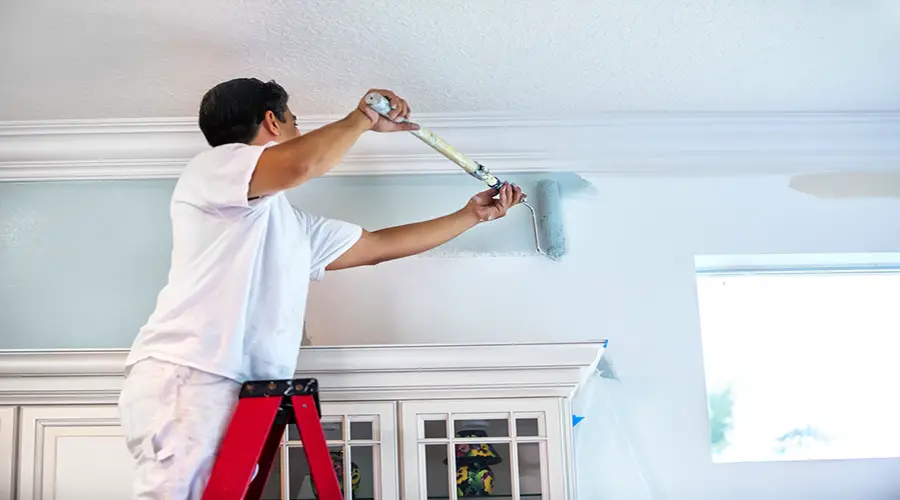
What To Do If You Accidentally Use Exterior Paint Inside
By now you should realize that painting the inside of your home is a bad, and potentially harmful, idea. However, accidents happen, so what should you do if you accidentally use exterior paint indoors?
- Improve Ventilation – The first thing to do once you realize that you’ve used exterior paint indoors is to open windows and turn on fans to improve ventilation. Try your best to quickly create airflow to direct the paint fumes and VOCs out of your home.
- Leave the Premises – Once you’ve done your best to improve ventilation around the painted area, it’s best to exit the premises. The less exposure you have to VOC emissions and exterior paint fumes trapped indoors, the better.
- Remove the Paint – There are many options for removing exterior paint you used indoors, including replacing the drywall, scraping the paint, or sanding it off. Consider consulting a local painting expert to decide which method is best for you.
Final Thoughts
Exterior and interior paint have many similarities, but the increased VOC emissions of exterior paint especially make it unfit for use indoors. Oil and latex-based paints emit large amounts of harmful fumes while drying and curing, especially those formulated for outdoor use. Even after the paint has cured, it can emit lower levels of fumes.
You should never use exterior paint indoors because there is not enough ventilation to get rid of the fumes. Additionally, exterior paint is typically softer and more prone to scrapes and scratches, which are a significant consideration on interior walls where you expect regular wear and tear.


